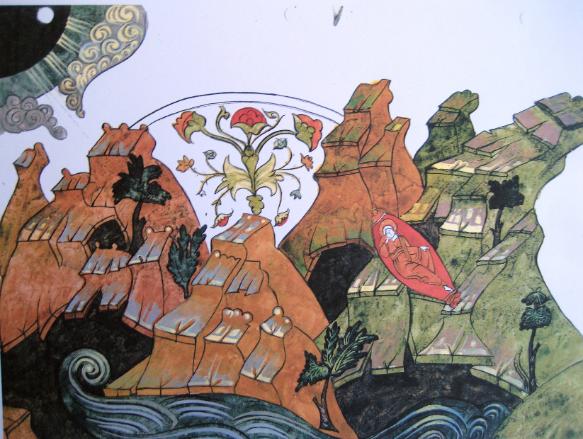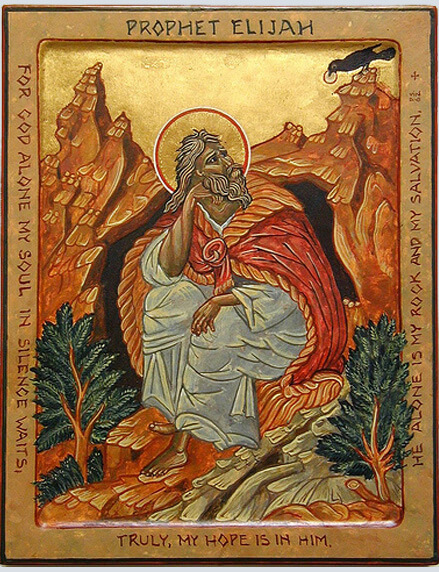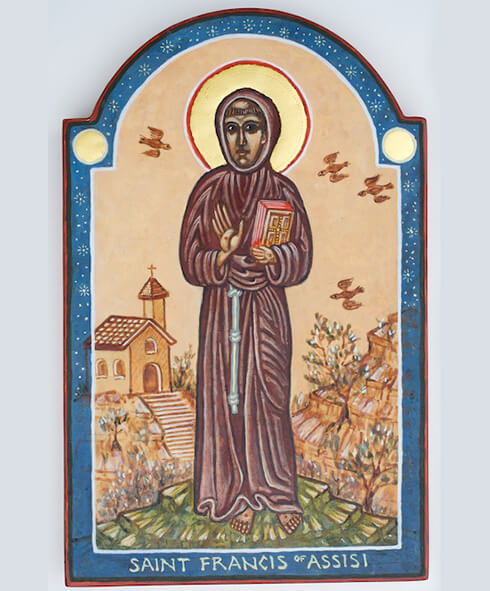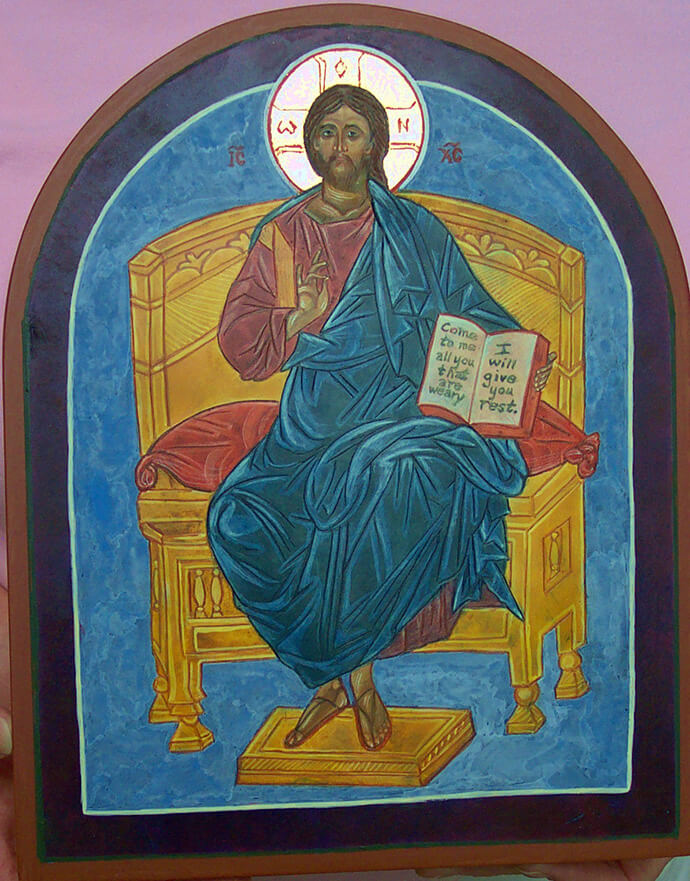LANDSCAPE in icons is often highly stylized, as shown in this demonstration piece/ highlight study by Vladislav Andrejev, founder of the Prosopon School of Iconology. This sampler piece provides suggestions for treatment of rocks, mountains, caves, ocean, clouds, and vegetation.
These two icons of the Prophet Elijah show very different treatments of landscape elements.
As in many other icons, the landscape includes a cave, representing the deep and unknown (although not necessarily evil) mysteries that hide within the visible nature which surrounds us, and within our own psyches.
In some icons, the cave becomes more menacing, the home of hungry lions and destructive dragons!
It also forms an effective frame for the heroic figures of Elijah (above left) and Daniel (left), shown posed neatly against the cave opening.
Rocks and mountains have a distinct shingled configuration - "stair steps to heaven." At the top, they may end in little rounded or slanted topknots, highlighted for definition.
John the Baptist said that God could raise up children to Abraham from the stones - and in icons, the towering rock formations tend to assume a human-like profile. They lean or rotate inwards toward the sacred event, as though hoping for a better view!
Water is usually depicted very dark green or blue-green with lighter wave marks, and often carries a symbolism similar to that of caves - the mysterious and potentially dangerous unknown. Waves may be depicted as very large and threatening. In the "Ubuntu Trinity" at left, I wanted to depict a peaceful stream, and used smaller waves.
Clouds, like water, may be shown as extremely active. In the icon of Prophet Daniel, the clouds are carrying a friend to his rescue. Even wispy clouds can provide a sense that the wind is blowing and the Spirit is at work, as in the detail at right of "The Angel of Saint Gregory's Church" by Paul Fromberg.
BUILDINGS in icons have their own style of perspective, in which the building is turned inside out to enable the viewer to see both interior and exterior, as the angels see them. Western-style perspective, with its consistent vanishing point(s) in the distance, would be too restrictive.
Instead, perspective may actually be inversed, with the wider part of a rectangular solid in back of the narrower part - the sight lines converge at the viewer's eye rather than in the distance.
In Loretta Hoffmann's icon of Saint Mark writing his Gospel, we seem to be looking up at one of the two buildings, and down on the other.
The dark window and door openings function similarly to caves - there's a mystery inside.
In a number of icons, including The Annunciation (left) and The Presentation(above right), the action takes place in the magnificent Temple, the epicenter of Jewish culture and religion. Although the Temple was destroyed in 70 AD, it remains the symbolic prototype of every Orthodox church building.
In the Annunciation icon, Mary is spinning yarn, just as a new creation will be "spun" inside her womb during her pregnancy. This red yarn will be used for the weaving of a new temple veil for the Holy of Holies - the same veil that is torn in half at the Crucifixion. The same (?) red cloth appears draped over the rooftops, indicating that the action takes place inside the building.
The building behind Mary is a well, indicated by the hole in its lower roof - but why a side door? Its upper roof is shaped into the letter "M" for Mary.
In the rear is the Pinnacle of the Temple, from which Jesus will be tempted some 30 years later to throw himself down. We see the foundations which will be shaken. The narrow structure with double pilasters, at left in the Annunciation icon and at right in the Presentation, is a recurrent feature which sometimes includes a throne-like seat between the pilasters.
FURNITURE, like buildings, is shown in inversed perspective, and may include mysterious dark openings.
Furniture does not necessarily sit on the ground - it sometimes floats in the foreground with its holy figure, occupying another plane in space-time. The footstool is of special symbolic importance, indicating that the saint is lifted above the earth.
Upholstered furniture was not invented until relatively recent centuries - so a bolster-like cushion may soften the seat.
Furniture may be adorned with ornamental carvings and with radiating fine lines or "assiste" in the second and third highlights, over a more sculptural first highlight.
Christ Enthroned by Loretta Hoffmann














